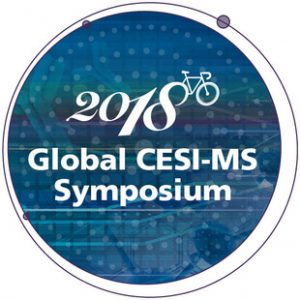 There are a lot of conferences vying for your attention every year. The Global CESI-MS Symposium on October 10-11 in the Netherlands is one you can’t afford to miss. It is the place to hear about the latest advancements made through the adoption of CESI-MS technology.
There are a lot of conferences vying for your attention every year. The Global CESI-MS Symposium on October 10-11 in the Netherlands is one you can’t afford to miss. It is the place to hear about the latest advancements made through the adoption of CESI-MS technology.
Have you signed up yet? If not, keep reading to find out more.
What is CESI-MS?
The integration of Capillary Electrophoresis (CE) with Electrospray Ionization (ESI) into a single dynamic process within the same device brings new capabilities to biopharmaceutical, proteomics, metabolomics, and industrial researchers. When paired with a mass spectrometer, CESI-MS delivers a revolutionary approach to discovering previously undetectable characteristics from the minutest precious sample.
The Global Symposium provides a platform for scientists in biopharma, proteomics, metabolomics research, and applied markets to share knowledge and advance their work with CESI-MS technologies. Organized by SCIEX, over the last three years, the event has become synonymous with innovation, check out last year’s presentations.
What’s on the Agenda?
Find out about the unique features of CESI-MS and how it is helping to push research and applied applications to the very limits. You will hear how CESI-MS is making inroads in applications where researchers are working with very limited amounts of samples, such as charged and polar analytes in metabolite profiling, and intact proteins in proteomics and biopharma. Professor Govert Somsen and Professor Manfred Wuhrer will host the two-day program which is packed with presentations and Q&A sessions featuring 15 industry innovators – see the full agenda here.
What’s New In CESI-MS in 2018?
At the Symposium you will hear about scientific breakthroughs in a range of applications, including:
- Is the Signature Peptide for Quantification a Thing of the Past? Using CESI-MS to Quantify mAbs With a Pseudo Intact or Intact Approach
Richard Snell, GSK, UK
TOF-MS is a common tool in peptide mapping and characterization. Coupled with capillary electrophoresis (CE), GSK developed a more robust and sensitive approach for quantitative bioanalysis of monoclonal antibodies (mAbs) with run times under 15 minutes, using a pseudo intact rather than signature approach. - The Top to Bottom of Protein Phosphorylation Using CESI-MS
Professor Claire Eyers, Liverpool University, UK
Liverpool University has overcome the inherent difficulties of defining multiple post-translational modifications (PTMs) sites. Capillary electrophoresis (CESI) with high-resolution MS has been used to explore PTM space and proteoform heterogeneity by separating intact phosphoproteins based on the level of their phosphorylation. - The Detection of Pesticide Metabolite TFA by CESI-MS
Dr. Sven Stuke, Bayer, Germany
Trace residue analysis of breakdown products, more polar compounds – or even (permanently) charged target compounds – pushes conventional methods to the limits in plant, animal, soil and water matrices. Bayer has developed a new CE-MS/MS-based approach: a GLP-validated residue analytical method for charged compounds. - Corona Isolation Method Matters: CESI-MS-Based Comparison of Corona Compositions Following on-Particle Versus In-Solution or in-Gel Digestion
Dr. Klaus Faserl, Innsbruck Medical University, Austria
Despite over 700 corona studies to date, very little is understood in terms of which methods provide the most precise and comprehensive characterization of the corona. Discover how Innsbruck Medical University is applying CESI-MS to nanomaterial corona analysis methods, enabling the detection of more peptides and proteins in a shorter time.
These are just four examples of the many exciting pioneering stories we will hear at the 2018 Global CESI-MS Symposium.
Why Should I Attend?
Over two days of presentations and Q&A, you will discover strategies, methods, and breakthroughs achieved with CESI-MS. This is a rare opportunity to hear and discuss these great cases, first-hand.
So, what are you waiting for? Come and join us at the 2018 Global CESI-MS Symposium on October 10-11, 2018 at Leiden University Medical Center (LUMC) in The Netherlands.
Spaces are filling fast; we hope to see you there.






 Contact Support
Contact Support
0 Comments